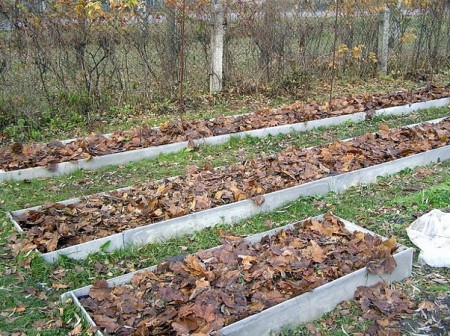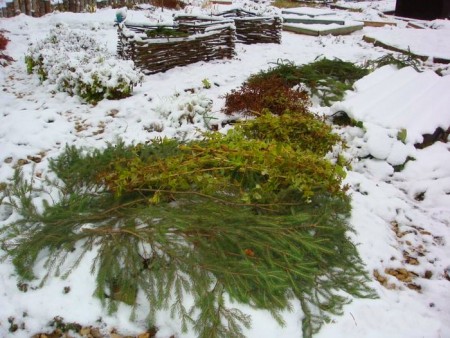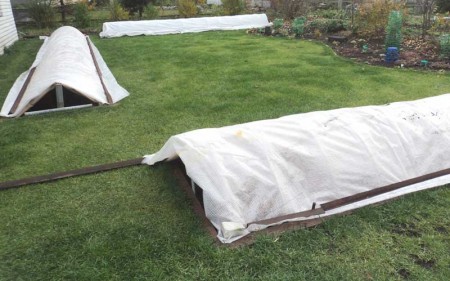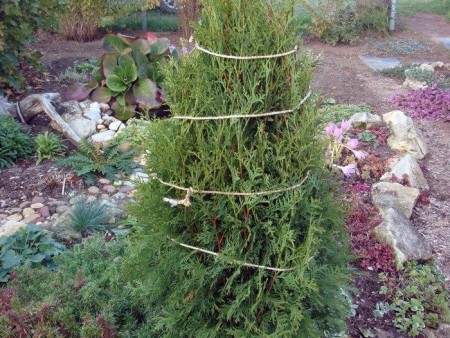Article from the series “Calendar of work for a gardener, gardener, florist”
Your flower garden: work of the month.
In the November garden, all that remains from the recent multicolor is a reddish-yellow carpet of leaves underfoot and bright spots of ornamental cabbage. The cool November air forces you to take active warming actions. And there is no time to engage in contemplation for a long time, there is still a lot of work in November, and little time.
What work does flower growers have left for November?
Experienced flower growers have little to do by November. Perennials are ready for winter: pruned and mulched. The areas for winter sowing of cold-resistant annuals have been dug up, fertilized, and seeding furrows have been made in them.
Roses, clematis are pruned, filamentous yuccas are tied. Covering material has been prepared for them. The rhizomes, tubers, and corms of plants that do not overwinter in open ground have long been dug up. The most decorative bushes of garden annuals were transplanted into pots. Indoor plants have been returned under the roof. But there are still things to do for November...
Care must be taken to ensure that perennials and biennials overwinter well, especially those that are not frost-resistant enough, because winter almost every year brings frosts and thaws, but does not guarantee a lot of snow, which saves plants from freezing.
It is necessary to thoroughly cover clematis
Therefore, we will cover the base of the already trimmed rose bushes and clematis with compost and throw them in with leaves. We remove the short shoots of clematis that bloomed on last year's shoots from the trellis, carefully lay them on the ground, cover them with leaves and cover them with non-woven material.
In the southern regions, you can wrap clematis shoots without removing them from their support. This way they will survive the winter even better. The main thing is to find something to cover it with: a thick non-woven material folded in several layers, an old blanket.
For clematis lovers, we recommend reading:
- "Clematis in autumn" - all about working with clematis in the fall.
- “Preparing clematis for winter” — how to prune and cover clematis
With the arrival of frost, we cover the roses
We finally cover rose bushes that have been hilled up or sprinkled with compost only after the thermometer drops to minus 5-7 degrees.Roses do not need dampness, so it is advisable to ensure that the roses remain dry and ventilated under cover.
A good cover option is film or non-woven material on arches. We leave vents on the sides for ventilation, which we close only in severe frosts.
Useful articles for rose lovers:
- "Roses in Autumn" — all about working with roses in the fall.
- "Sheltering roses for the winter" - how to cover different types of roses.
Let's cover the bulbous ones
We cover the bulbous plantings with a thin layer of leaves, primarily hyacinths, daffodils, oriental and trumpet lilies. We mulch tulips bought at sales and planted later than the optimal time: let the soil not freeze longer and the bulbs take root.
Let's try winter sowing
If we have prepared a plot where annuals are planned to bloom next year, we can sow seeds after frost. Let’s make sure once again that the place for pre-winter sowing has been chosen well: it will not warm up too much on sunny winter days, the snow will be blown away by the wind, and the seeds will be washed away from the site by spring waters.
Sow the seeds densely cold-resistant annuals into grooves prepared in advance. For small seeds they are no deeper than 1 cm, for large ones - 3-5 cm. After sowing, we fill them with pre-prepared soil mixture. In autumn you can sow seeds:
- chrysanthemum keeled
- Phlox Drummond
- scabioses
- snapdragon
- cosmos doubipinnate
- Iberis
- calendula
- Delphinium Ajax
- cornflower annua
- nigels
- Eschsolzia
- Chinese asters
and other annuals, the seeds of which are stored in reserve in our own flower beds. You can even sow in the snow. In a flower garden, snow is trampled down where sowing is supposed to take place.Seeds are sown on strips of compacted snow, sprinkled with pre-prepared soil mixture and covered with snow.
Seeds are sown in the frost perennial flowers that require stratification. They are sown in the same way as annual seeds. After winter sowing the following sprout well:
- rudbeckia
- lupine
- oriental poppy
- delphinium
- gaillardia
- aquilegia
and many others. The seeds, having undergone cold treatment and saturated with snow water, will give life to resistant plants in the spring.
In addition, pre-winter sowing will free us in the spring for other urgent work.
It often snows in November. Later, he may melt away, but manages to play a prank - break the branches of coniferous trees. To prevent this from happening, we tie the branches of the pyramidal conifers with twine so that they do not fall apart or break off under the weight of the snow.
While the soil is not frozen, we will prepare leaf soil and compost for growing flower seedlings and spring replanting of indoor plants.
We check the basement regularly preservation of rhizomes, pubes and roots of ornamental plants in order to notice signs of diseases in time and prevent their spread. If the soil on the canna rhizomes and chrysanthemum roots is dry, moisten it. We sort and store gladioli corms kept warm after digging.
If the weather does not allow you to work in the country, let's put the seeds in order: clean them, scatter them into bags and boxes. We will clear the gladioli corms dug up in October from the roots and soil and store them in a cool, dry place.
We put the dried begonia tubers in plastic bags and cover them with sand or sawdust. It is better to store begonias in the refrigerator - in the vegetable drawer.
Indoor plants have their own challenges in winter.
To make it easier for them to survive a lack of light, excess heat, and dry air, you need to organize wintering taking into account the requirements of each plant.
People from the subtropics (laurel, boxwood, myrtle, lemon, etc.) feel better in cool rooms: on an insulated loggia, veranda. Care in such a microclimate comes down to rare watering and loosening of the soil.
Most cacti It is better to winter in a bright, cool place. They can be placed closer to the window glass and away from heat sources.
Blooming cyclamens, azaleas We find a bright, cool place and try to humidify the air around them by placing them in wide trays with wet expanded clay or sand.
And we’ll try to protect all the plants from dryness: we spray them and give them a warm shower once a week.





 CUCUMBERS NEVER GET SICK, I'VE BEEN USING ONLY THIS FOR 40 YEARS! I SHARE A SECRET WITH YOU, CUCUMBERS ARE LIKE THE PICTURE!
CUCUMBERS NEVER GET SICK, I'VE BEEN USING ONLY THIS FOR 40 YEARS! I SHARE A SECRET WITH YOU, CUCUMBERS ARE LIKE THE PICTURE! You can dig a bucket of potatoes from each bush. Do you think these are fairy tales? Watch the video
You can dig a bucket of potatoes from each bush. Do you think these are fairy tales? Watch the video
 How our fellow gardeners work in Korea. There is a lot to learn and just fun to watch.
How our fellow gardeners work in Korea. There is a lot to learn and just fun to watch. Eye trainer.The author claims that with daily viewing, vision is restored. They don't charge money for views.
Eye trainer.The author claims that with daily viewing, vision is restored. They don't charge money for views. A 3-ingredient cake recipe in 30 minutes is better than Napoleon. Simple and very tasty.
A 3-ingredient cake recipe in 30 minutes is better than Napoleon. Simple and very tasty. Therapeutic exercises for cervical osteochondrosis. A complete set of exercises.
Therapeutic exercises for cervical osteochondrosis. A complete set of exercises. Which indoor plants match your zodiac sign?
Which indoor plants match your zodiac sign? What about them? Excursion to German dachas.
What about them? Excursion to German dachas.